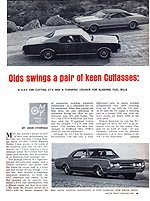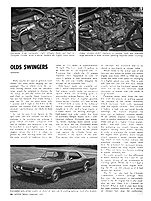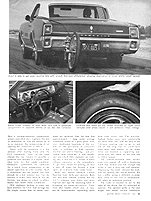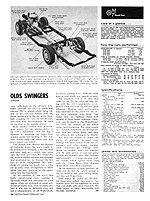|
|
|
This package consists of a high-compression 400-cubic-inch with a 2-barrel carburetor and special cam that moves the torque peak to a lower rpm than normal driving through a 2.41 rear axle. Also included is something particularly delightful, we think: the 4-4-2 suspension and chassis. A car this equipped can be correctly considered a 4-4-2 (less identification) with a different gine and final drive ratio. We made the obvious choice of a 4-4-2 -- with an almost identical list of accessories, including automatic transmission -- as a companion test car for comparison. Other than engines and final drive, the only differences in equipment having any effect on performance were tires and brakes. The 4-4-2 had F70-14 Wide Ovals and front discs while the TC-equipped Cutlass had the standard 7.75 x 14 tires with drums. (The standard tires were later changed to UniRoyal Max 195R14 radial ply tires for evaluation.) |
Without hesitation we rate the TC-packaged car above the 4-4-2 as an all-around road car for this reason. This goes for all kinds of roads -- not just turnpikes -- because with an identical suspension, it gives away nothing to the 4-4-2 in this department. Well, maybe it's tops in general roadability, but what about digging out and passing? This is where even the carwise, having merely read the specifications, might be tempted to dismiss the TC setup as just the ticket for Mom and Dad or maybe Aunt Genevieve, but not for himself. Far from being a slug, our TC test car gave away only 1 second and 6 mph to the 4-4-2 in the quarter and hacked 0-60 in less than 9 seconds -- performance not likely to bore anyone.
As can be seen from figures in the spec table, the real clincher for the TC package is the excellent gas mileage it gives, which favorably compares with that of smaller, less powerful V-8s and 6s installed in much lighter cars. A typical example of its performance in this respect versus the 4-4-2 is when we gassed up after driving both cars over the same stretch of highway for a distance of 213 miles at approximately 70 mph. The 4-4-2 took 16 gallons to fill while the TC car required only 13. Premium fuel (which the TC engine requires, too) happened t cost 42 cents a gallon at that particular location. So you can readily imagine the savings on an extended trip. Olds hasn't made one available yet, but a lower-compression-ratio, regular-fuel engine would make an attractive option. While not recording quite so spectacular mileage figures, the 5- or 6-cent cheaper price of regular gasoline would permit a further 10% cost saving. A brief look at some of the technical factors involved might provide some insight as to why such a large engine in a fairly heavy car driving through a high-speed rear axle yeields this kind of economy. Simply stated, such a combination reduces frictional and pumping losses, making more power available to drive the car. Frictional losses -- the power required to turn the crank on its bearings, scrape of the pistons rings against the cylinder bores, etc. -- increase as the square of the rpm. This means that when rpm is reduced by one-half, the frictional loss is reduced to one-fourth its former value. |
Much closer to the actual case of our two test cars would be where you reduce engine rpm from 2800 to 2000 but still retain the same road speed by changing to a higher speed rear axle. This is only 800 rpm less, but you will have almost exactly halved the frictional power loss. Now you can see why relatively small decreases in engine rpm can result in large benefits. Pumping losses stem from the useless work the pistons do pulling against the vacuum in the intake manifold, which increases both with increased rpm and higher vacuum. This vacuum is highest at high rpm and small throttle openings -- the typical situation for most cars at highway cruising speeds. In an almost utopian manner htings start to resolve themselves in your favor when you go to a higher (lower numerically) rear-axle ratio. First, there's less pumping loss simply because the engine's turning more slowly. Second, in order to maintain the former speed, the engine must produce more torque which requires a large throttle opening which in turn further reduces the manifold vacuum. (The engine must have the potential for increased torque, which is where the large engine comes in.) Thus you have two factors working to reduce pumping loss. We could actually feel the difference in losses between the 4-4-2 and TC car by merely lifting off the accelerator at cruising speed. While the 4-4-2 had a strong deceleration from engine braking, the TC car felt almost as if it had shifted to neutral.
The TC car also had the Climatic Combustion Control package. New this year, the accessory is particularly suited to the TC engine but is also available on any Olds V-8 -- 2-barrel or 4-barrel. What it does is pipe heat from the right exhaust manifold to a special air cleaner box atop the carburetor. Here a vacuum-powered, temperature-sensor-controlled door regulates the mix of underhood air with the heated air so as to maintain the temperature of air entering the carburetor at 100º F. Since, with the exception of a few minutes after starting from cold, the CCC carburetor "lives" in the same climate the year 'round, it's possible to calibrate fuel mixture to a leaner, more ideal ratio for this single condition. Ordinarily, carburetors are calibrated for a much lower temperature to get a decent operation in cold weather. Such a calibration lets the engine run well enough on a hot summer day, but the mixture is richer than need be for the warmer, less dense air which, in effect, wastes fuel under those conditions. |
Olds engineers decline to state any hard numbers for CCC fuel savings for the simple reason that so many variables are involved. One did hint that approximately 1 mpg under average conditions would be a good guess, however. Additional functions of this system are the prevention of carburetor icing -- a problem in high humidity weather just above freezing -- and providing rapid warm-up. A side benefit, and one which Olds engineers are looking into, is that the CCC results in lower exhaust emissions to the atmosphere. To get extra punch for passing, all heat is shut off when the throttle is wide oopen; air is drawn from under the hood. Both cars shared identical Cutlass Supreme body shells and interiors. Both also had dual exhaust systems but the 4-4-2's tailpipes were lower and more exposed and had the annoying habit of dragging on steep driveways. They were also louder which may or may not be objectionable, depending upon how your tastes run. The narrow-backed bucket seats were comfortable for short stints and, with the help of the Tilt-away steering, easy to get in and out of. On long trips we could have used more side support to the upper torso and resorted to supporting ourselves with one elbow on the arm rest to relieve fatigue. The console-mounted shift mechanism was topped off with a handsome knob that looked and felt enough like wood to fool at least one staff member. Depressing this knob released the lockouts for shifting into low or reverse. We feel a stiffer spring is definitely in order here, since it's too easy to unintentionally select an unwanted position.
The radio is located so far to the right of the driver that it's awkward to operate. The speaker grille is flat and bright and under certain conditions casts reflections in the driver's eyes. Other controls are easy to reach and operate. We've griped about being unable to see very far behind with the inside mirror due to the top of the backlight cropping the view on lots of cars, and these were no exceptions. As usual we resorted to using the outside mirror. Body quality control was generally good except for one glaring defect in the 4-4-2. Somebody used too big a hammer in installing the right front window guide rail, bending it. The window would jump the track and stop every time it was raised. The person who okayed the method of fastening down the spare ought to be sentenced to changine a flat one dark and rainy night on a muddy road using only the tools provided. We found the lug wrench useless because the threaded stud protruded too far through the hex nut to allow engatgement. We don't think it's asking too much for a wing nut or some other arrangement to allow quick and easy removal of the spare, using only the bare hands. As we received it, the 4-4-2 had badly out-of-round tires, causing a vibration which was alleviated to some degree when we switched to some not-so-out-of-round tires. Just to make certain it was due to defective tires and not a characteristic of all WIde-Ovals, we drove another 4-4-2 with the same kind of tires which was smooth as glass. |
The standard 7.75 x 14 tires that came on the TC were the best riding with the 4-4-2 suspension, as expected. They are fairly fat and had good adhesion. Braking and performance data recorded in the panel for the TC car were obtained with them. The radial tires we replaced them with seemed to have better adhesion (however, not as much as the Wide-Ovals) but were the noisiest of the bunch under hard cornering. We were caught in a sudden cloudburst on an expressway with the radials fitted, and their wet adhesion left nothing to be desired. We have no reason to doubt the claims of markedly increased tread mileage for these radials from our experience with other makes. Another claim -- increased gas mileage compared to normal tires -- we checked over the same section of road and speed as with the standard tires. We recorded approximately a .3-mpg increase with the radials which agreed fairly well with the .2-mpg figure Olds obtained under more controlled conditions. As for sensitivity to poor surfaces, tar strips and the like, the radials seemed to fall in between the good riding standard tires and Wide-Ovals. Olds makes no claims of "all new" for these cars (which they aren't), but seldom have we encountered so much that was really new on a road test. We think many of these innovations will become universal. |
|
|
||||||||||||||||||||||||||||||||||||||||||||||||||||||||||||||||||||||||||||||
|
|||||||||||||||||||||||||||||||||||||||||||||||||||||||||
|
|||||||||||||||||||||||||||||||||||||||||||||||
 |
 |
 |
 |
Back to Media Reports listings |
|
Want to link to this site? Please
use this banner. The correct URL for this website is http://www.OLDSmobility.com/) |